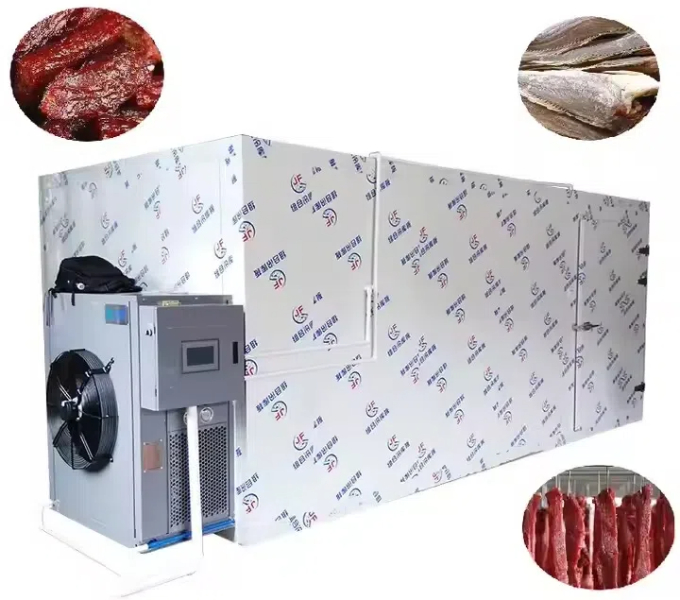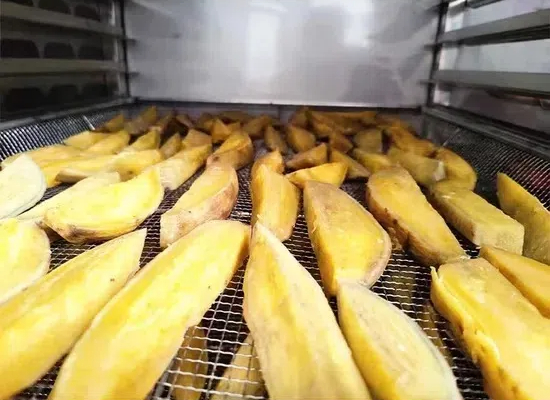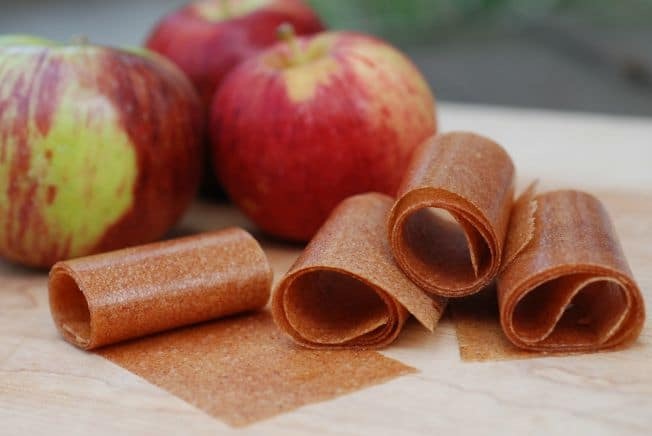
Content Menu
● How Does a Food Dehydrator Work?
● Benefits of Using a Food Dehydrator
● Types of Food Dehydrators
● Choosing the Right Food Dehydrator
● How to Use a Food Dehydrator
● Common Foods Suitable for Dehydration
● Tips for Successful Dehydration
● Cleaning Your Food Dehydrator
● Advanced Techniques in Food Dehydration
>> Vacuum Sealing Post-Dehydration
● Recipes Suitable For Dehydration
>> Dried Apple Chips
>> Vegetable Medley Chips
● Health Benefits Associated With Consuming Dehydrated Foods
● User Experiences With Specific Brands/Models
● Common Mistakes Made During Dehydration Processes
● Cultural Practices Related To Dehydration Globally
● Sustainability Aspects Tied To Home-Based Practices
● Conclusion
● Frequently Asked Questions (FAQs)
>> 1. How long does it take to dehydrate food?
>> 2. Can I dehydrate meat?
>> 3. What foods can I dehydrate?
>> 4. Do I need to rotate trays during dehydration?
>> 5. How should I store dehydrated foods?
● Citations:
Food dehydrators are specialized appliances designed to remove moisture from various foods, effectively preserving them for extended periods. This process not only prolongs the shelf life of fruits, vegetables, and meats but also enhances their flavors and nutritional value. In this article, we will explore the mechanics of food dehydrators, their benefits, types, and how to choose the right one for your needs.

How Does a Food Dehydrator Work?
A food dehydrator operates by circulating warm air around the food placed on its trays. The key components of a dehydrator include:
- Heating Element: This generates heat to evaporate moisture from the food.
- Fan: It circulates air evenly throughout the dehydrator, ensuring consistent drying.
- Trays: These hold the food items and are usually perforated to allow air to flow through.
The dehydration process typically involves low temperatures ranging from 85°F to 160°F (approximately 30°C to 70°C). This gentle heat removes moisture without cooking the food, thus preserving its nutrients and flavor. The process can take several hours, depending on the type of food and its moisture content.
Benefits of Using a Food Dehydrator
1. Extended Shelf Life: Dehydrating food significantly extends its shelf life by inhibiting bacterial growth and spoilage. By removing moisture, the dehydrator allows you to store your favorite fruits, vegetables, and snacks for months. This means fewer trips to the grocery store and less food waste[1].
2. Nutrient Retention: Unlike some preservation methods that can degrade nutritional value, dehydration helps retain essential vitamins and minerals. The food dehydrator ensures that your dried fruits and veggies maintain their health benefits, giving you a nutritious snack option without added preservatives[1].
3. Cost-Effective: Investing in a food dehydrator can save you money in the long run. Dehydrating your food at home is often more cost-effective than purchasing pre-packaged dried goods. With an electrical food dehydrator machine, you can buy in bulk and preserve your food at a fraction of the cost[1].
4. Convenience and Versatility: An electrical food dehydrator machine offers unparalleled convenience. It allows you to dehydrate a variety of foods, from fruits and vegetables to herbs and even meats. This versatility makes it an indispensable tool for anyone interested in exploring different preservation methods and recipes[1].
5. Healthy Snack Options: Say goodbye to unhealthy snacks laden with preservatives and additives. Dehydrated snacks are a healthier alternative. You can make your own dried fruit, vegetable chips, or jerky, ensuring that you control the ingredients and enjoy guilt-free treats[1].
6. Space-Saving Storage: Dried food takes up significantly less space than fresh or frozen alternatives. By using an electrical food dehydrator machine, you can store more food in less space, making it easier to organize your pantry and reduce clutter[1].
7. Enhanced Flavor Concentration: Dehydration concentrates the flavors of fruits and vegetables, making your snacks more flavorful. Whether you're enjoying a sweet apple chip or a savory vegetable crisp, the taste is intensified, providing a more satisfying snacking experience[1].
8. Eco-Friendly Choice: Using an electrical food dehydrator machine is an eco-friendly choice. It reduces food waste by enabling you to preserve excess produce. Moreover, it uses less energy compared to freezing, making it a greener option for food storage[1].
9. Preparation for Cooking: Dehydrated foods can be rehydrated for cooking, adding a new dimension to your culinary repertoire. You can prepare soups, stews, and other dishes with dried ingredients, making meal preparation more efficient and flavorful[1].
Types of Food Dehydrators
There are two main types of food dehydrators:
- Stackable Dehydrators: These feature several trays stacked vertically. They are often more budget-friendly but may require rotating trays during use for even drying.
- Horizontal Airflow Dehydrators: These have a fan and heating element located at the back or side of the unit, allowing for more even drying without needing to rotate trays. They tend to be more efficient for larger batches.
| Type | Pros | Cons |
| Stackable Dehydrators | Budget-friendly; easy to store | May require tray rotation |
| Horizontal Airflow | Even drying; no need for rotation | Generally more expensive |
Choosing the Right Food Dehydrator
When selecting a food dehydrator, consider the following factors:
- Capacity: Choose a model that suits your needs based on how much food you plan to dehydrate at once.
- Energy Efficiency: Look for models that use less power while still providing effective drying capabilities.
- Ease of Use: Features like adjustable temperature settings and timers can make operation simpler.
- Durability: Opt for units made with high-quality materials that can withstand regular use.
How to Use a Food Dehydrator
Using a food dehydrator is straightforward:
1. Preparation: Wash and slice your fruits or vegetables into uniform pieces for even drying.
2. Loading Trays: Place the prepared food on the trays with enough space between pieces for air circulation.
3. Setting Temperature and Time: Adjust the temperature based on the type of food (e.g., fruits at 135°F, vegetables at 125°F) and set the timer according to recommended drying times.
4. Monitoring Progress: Check periodically to ensure even drying; some foods may require longer than others.
5. Storage: Once dried, store your foods in airtight containers away from light and moisture to maintain freshness.

Common Foods Suitable for Dehydration
Many types of foods can be effectively dehydrated:
- Fruits: Apples, bananas, strawberries, mangoes
- Vegetables: Carrots, bell peppers, zucchini
- Herbs: Basil, oregano, thyme
- Meats: Beef jerky (ensure it's cooked first)
- Grains & Legumes: Rice (pre-cooked), lentils
Dehydrating these foods not only preserves them but also enhances their flavors.
Tips for Successful Dehydration
To achieve optimal results when using a dehydrator:
- Cut foods into uniform sizes for even drying.
- Blanch certain vegetables before dehydration to improve color retention.
- Avoid overcrowding trays; allow space between pieces for air circulation.
- Monitor temperatures closely; different foods require different settings.
- Store dried foods properly in airtight containers in cool places.
Cleaning Your Food Dehydrator
Maintaining cleanliness is essential for optimal performance:
1. Disassemble all removable parts after each use.
2. Soak trays in warm soapy water if they have sticky residues.
3. Wipe down the interior with a damp cloth.
4. Ensure all parts are completely dry before reassembling.
Regular cleaning prevents cross-contamination between different types of foods being dehydrated.
Advanced Techniques in Food Dehydration
To maximize efficiency when using your food dehydrator machine, consider implementing advanced techniques such as vacuum sealing after dehydration:
Vacuum Sealing Post-Dehydration
Vacuum sealing is crucial because it removes air that could lead to oxidation—this significantly prolongs shelf life while retaining flavor integrity! Here's how you do it:
1. Once your fruits or veggies are fully dried (check by ensuring they snap rather than bend), let them cool completely.
2. Place cooled items into vacuum-sealable bags ensuring no moisture remains inside before sealing tightly using any available vacuum sealer device.
3. Store these sealed bags away from light sources—ideally in dark cabinets or pantries—to prevent degradation over time!
This method ensures that your dried goods stay fresh longer without compromising on taste or texture!
Recipes Suitable For Dehydration
Here are some delicious recipes that work well with *food dehydrators*:
Dried Apple Chips
Ingredients:
- Fresh apples
- Cinnamon (optional)
Instructions:
1. Core apples without peeling them.
2. Slice them thinly (about ¼ inch thick).
3. Sprinkle cinnamon if desired.
4. Arrange slices on trays ensuring they don't overlap.
5. Set dehydrator at 135°F until crispy (around 6–8 hours).
Vegetable Medley Chips
Ingredients:
- Zucchini
- Carrots
- Sweet potatoes
- Olive oil & seasoning mix
Instructions:
1. Wash & slice vegetables uniformly.
2. Lightly coat with olive oil & seasoning mix.
3. Spread evenly on trays.
4. Set at 125°F until crispy (approximately 4–6 hours).
These recipes not only provide nutritious snacks but also allow experimentation with flavors!
Health Benefits Associated With Consuming Dehydrated Foods
Incorporating *dehydrated foods* into one's diet offers numerous health benefits:
- Reduced Risk Of Cancer: Dried fruits & veggies may play roles in reducing risks associated with certain cancers due largely due their concentrated nutrient profiles which activate protective chemicals during dehydration processes[14].
- Improved Digestion: As fiber content increases through dehydration methods—this aids digestive health significantly preventing issues like constipation![14].
- Increased Energy Levels: Concentrated calories found within dried products give quick boosts ideal especially during physical activities like hiking or camping trips![14].
User Experiences With Specific Brands/Models
Users often share positive feedback regarding specific food dehydrators. For instance:
- The Excalibur model is frequently praised for its durability over years coupled with excellent performance across various types of foods including herbs & meats alike!
Testimonials reveal that many users appreciate how easy it becomes turning excess produce into long-lasting snacks without any preservatives added—making it both economical & healthier choice overall!
Common Mistakes Made During Dehydration Processes
While using a food dehydrator, common pitfalls include:
1) Overloading trays leading uneven drying—always leave space between items!
2) Not checking temperatures regularly—each type requires specific settings!
3) Failing To Cool Before Storing—allowing items cool prevents condensation buildup inside storage containers leading mold growth later on!
Avoiding these mistakes ensures better outcomes every time!
Cultural Practices Related To Dehydration Globally
Dehydration isn't just practical—it's cultural! Across various regions worldwide people have utilized sun-drying techniques traditionally—think sun-dried tomatoes from Italy or jerky-making practices among Native American tribes!
These methods highlight humanity's ingenuity when faced with preserving resources efficiently while celebrating local flavors!
Sustainability Aspects Tied To Home-Based Practices
By choosing home-based dehydration methods over purchasing pre-packaged goods—consumers contribute positively towards reducing packaging waste associated with commercial products!
Moreover utilizing seasonal produce helps support local farmers thus promoting sustainable agriculture practices too!
Conclusion
Food dehydrators are invaluable tools for anyone interested in preserving food while enhancing its flavor and nutritional value. By understanding how they work and their benefits, you can make informed decisions about incorporating this appliance into your kitchen arsenal. Whether you're looking to create healthy snacks or preserve seasonal produce, investing in a quality food dehydrator can save money and reduce waste while providing delicious results.

Frequently Asked Questions (FAQs)
1. How long does it take to dehydrate food?
The time varies based on the type of food and its moisture content but generally ranges from 4 to 12 hours.
2. Can I dehydrate meat?
Yes, but it's recommended to cook meat first to an internal temperature of 165°F before dehydrating it for safety reasons.
3. What foods can I dehydrate?
You can dehydrate fruits, vegetables, herbs, meats, grains, legumes, and even flowers!
4. Do I need to rotate trays during dehydration?
In stackable dehydrators, it's often necessary to rotate trays for even drying; horizontal airflow models typically do not require this.
5. How should I store dehydrated foods?
Store dried foods in airtight containers in a cool dark place to maintain their quality over time.
Citations:
[1] https://etsolutions.in/10-amazing-benefits-of-electrical-food-dehydrator-machines/
[2] https://www.youtube.com/watch?v=lEUA2t2XD5M
[3] https://theinspiredhome.com/articles/a-beginners-gdeletee-to-dehydrating-food/
[4] https://www.youtube.com/watch?v=p5h2YQOwpfU
[5] https://www.wisdompreserved.life/how-to-clean-a-dehydrator
[6] https://www.webstaurantstore.com/guide/741/food-dehydrators-buying-guide.html
[7] https://www.osbheatpump.com/news/how-to-use-a-food-dehydrator-10-useful-tips-for-beginners-and-advanced-users/
[8] https://www.commercialdehydrators.com.au/dehydrating-recipes-filters
[9] https://www.bestbuy.com/discover-learn/10-reasons-to-buy-a-food-dehydrator/pcmcat1634332391134
[10] https://www.freshoffthegrid.com/dehydrating-food/
[11] https://www.youtube.com/watch?v=rXNIHzcE8F0
[12] https://www.goodhousekeeping.com/cooking-tools/g30200878/best-food-dehydrator/
[13] https://www.backcountrypaleo.com/cleaning-food-dehydrator/
[14] https://www.webmd.com/diet/dehydrating-food-good-for-you
[15] https://homesteadingfamily.com/preservation-101-intro-to-dehydrating-food/
[16] https://eatsleepwild.com/homemade-dehydrated-backpacking-meals/
[17] https://www.thespruceeats.com/best-food-dehydrators-4077285
[18] https://seedtopantryschool.com/quick-tips-on-how-to-clean-your-dehydrator/
[19] https://www.goodhousekeeping.com/appliances/a31904157/what-is-a-dehydrator/
[20] https://learn.eartheasy.com/guides/a-beginners-guide-to-dehydrating-food/
[21] https://www.backpackingchef.com/food-dehydrator-recipes.html
[22] https://www.reddit.com/r/dehydrating/comments/1grd7r2/im_searching_for_the_best_food_dehydrator_of_2025/
[23] https://farmerswiferambles.com/care-for-your-food-dehydrator/
[24] https://brodandtaylor.com/pages/dehydrating
[25] https://www.breville.com/content/breville/us/en/blog/cooking/how-to-use-a-dehydrator/_jcr_content/root/container_741553154/container/image.coreimg.85.1200.jpeg/1718622778417/how-to-use-dehydrator.jpeg?sa=X&ved=2ahUKEwjEyeuUjeqKAxXRUkEAHaLQIYcQ_B16BAgEEAI
[26] https://insanelygoodrecipes.com/dehydrator-recipes/
[27] https://www.allrecipes.com/thmb/IBOoLhB5IFlt9pVQ4R3Yo2vHXW4=/1500x0/filters:no_upscale():max_bytes(150000):strip_icc()/Testing_NescoFD-1040GardenmasterDigitalProFoodDehydratorforJerkyandSnacksWhite_148-e21e53645bf3480295e37ab0a7c733db.jpeg?sa=X&ved=2ahUKEwiV3fmCluqKAxUBLFkFHenzLn0Q_B16BAgLEAI
[28] https://images.thdstatic.com/catalog/pdfImages/80/807ed785-917a-4de7-9120-2adf8c7d405a.pdf
[29] https://www.healthline.com/nutrition/dehydrated-food
[30] https://www.allrecipes.com/article/how-to-use-a-food-dehydrator/
[31] https://www.youtube.com/playlist?list=PL6ygl2lNPriODiu2XahnHHUhj6mEObz0P
[32] https://www.foodandwine.com/lifestyle/kitchen/best-food-dehydrators
[33] https://www.reddit.com/r/dehydrating/comments/lkjdl8/im_new_how_do_i_clean_my_dehydrator_after/
[34] https://community.waring.com/blog/p/13or1/the-remarkable-benefits-of-adding-a-food-dehydrator-to-your-kitchen-arsenal
[35] https://www.sunbeam.com.au/recipes/dehydrator-recipes
[36] https://www.nytimes.com/wirecutter/reviews/best-food-dehydrator/
[37] https://nouveauraw.com/reference-library/dehydrator-basics/how-to-clean-and-care-for-your-dehydrator/
[38] https://www.thepurposefulpantry.com/easy-tips-to-clean-your-dehydrator/
[39] https://www.youtube.com/watch?v=1QOiMXwza90
[40] https://septree.com/pages/how-do-i-clean-my-home-food-dryer











